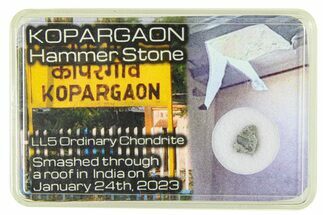This Specimen has been sold.
.45" Chelyabinsk Meteorite (1.08 g) - 2013 Witnessed Fall
This is a .45" wide (1.08 grams) Chelyabinsk meteorite from the largest meteorite fall in the past century. It comes in an acrylic display case.
The Chelyabinsk Meteorite - 2013 Witnessed Fall
On February 15th, 2013 at 9:22 a.m. local time, a tremendous fireball lit up the sky over the city of Chelyabinsk in southwest Russia. Shortly afterwards, a massive shockwave reported to be equivalent to a 300 kiloton explosion rocked the area. Windows were blown out in thousands of buildings and nearly 1,000 people were injured, primarily from flying glass. Some residents reportedly thought nuclear war and begun and the world was about to end.
The cause of this destruction was a meteor estimated 55 feet wide that had entered Earth's atmosphere before exploding 18 miles above the surface. This is believed to be the largest meteor to enter our atmosphere since the Tunguska meteor more than a century earlier.
Most of the meteor vaporized during the airburst, but thousands of small stones, most only weighing a few grams, rained down around several villages about 40 kilometers Southwest of Chelyabinsk. The meteorite stones and fragments ranged from less than a gram to 1.8 kilograms in weight. The total mass collected by local people is estimated to be between 100kg and 1000kg. Most of these stones have a black or brown fusion crust.
Meteoritical Bulletin: Entry for the Chelyabinsk Meteorite
On February 15th, 2013 at 9:22 a.m. local time, a tremendous fireball lit up the sky over the city of Chelyabinsk in southwest Russia. Shortly afterwards, a massive shockwave reported to be equivalent to a 300 kiloton explosion rocked the area. Windows were blown out in thousands of buildings and nearly 1,000 people were injured, primarily from flying glass. Some residents reportedly thought nuclear war and begun and the world was about to end.
The cause of this destruction was a meteor estimated 55 feet wide that had entered Earth's atmosphere before exploding 18 miles above the surface. This is believed to be the largest meteor to enter our atmosphere since the Tunguska meteor more than a century earlier.
Most of the meteor vaporized during the airburst, but thousands of small stones, most only weighing a few grams, rained down around several villages about 40 kilometers Southwest of Chelyabinsk. The meteorite stones and fragments ranged from less than a gram to 1.8 kilograms in weight. The total mass collected by local people is estimated to be between 100kg and 1000kg. Most of these stones have a black or brown fusion crust.
Meteoritical Bulletin: Entry for the Chelyabinsk Meteorite
What Is An L5 Chondrite?
An L5 chondrite is a type of stony meteorite that falls under the "L" (low iron) chondrite group. L chondrites have lower iron content (around 7-11% iron, mostly in the form of iron sulfide or silicates) and typically show less metal than H chondrites (high iron chondrites). They primarily consist of silicate minerals like olivine and pyroxene.
The "5" rating indicates a high degree of thermal metamorphism. This means that the L5 chondrite experienced substantial heating, likely on its parent asteroid, which caused partial recrystallization of minerals. As a result, the original chondrules (small, rounded particles) are less distinct and partially altered, though still visible. L5 chondrites usually have a light to medium gray matrix, and the chondrules tend to be less clearly defined due to metamorphic alteration. You may still see rounded chondrule outlines, but they appear partially integrated with the surrounding matrix.
The L chondrite group is believed to come from a specific parent body in the asteroid belt, which likely experienced a major collisional event. This event may have sent large quantities of L chondritic material into space, resulting in the abundance of L chondrites found on Earth.
An L5 chondrite is a type of stony meteorite that falls under the "L" (low iron) chondrite group. L chondrites have lower iron content (around 7-11% iron, mostly in the form of iron sulfide or silicates) and typically show less metal than H chondrites (high iron chondrites). They primarily consist of silicate minerals like olivine and pyroxene.
The "5" rating indicates a high degree of thermal metamorphism. This means that the L5 chondrite experienced substantial heating, likely on its parent asteroid, which caused partial recrystallization of minerals. As a result, the original chondrules (small, rounded particles) are less distinct and partially altered, though still visible. L5 chondrites usually have a light to medium gray matrix, and the chondrules tend to be less clearly defined due to metamorphic alteration. You may still see rounded chondrule outlines, but they appear partially integrated with the surrounding matrix.
The L chondrite group is believed to come from a specific parent body in the asteroid belt, which likely experienced a major collisional event. This event may have sent large quantities of L chondritic material into space, resulting in the abundance of L chondrites found on Earth.
TYPE
Chondrite (LL5)
LOCATION
Chelyabinskaya Oblast, Russia
SIZE
.45 x .32 x .28", 1.08 grams
CATEGORY
SUB CATEGORY
ITEM
#267438
 Reviews
Reviews












